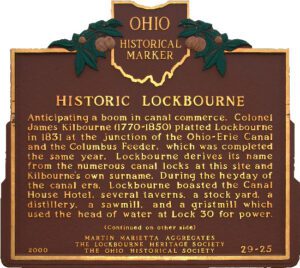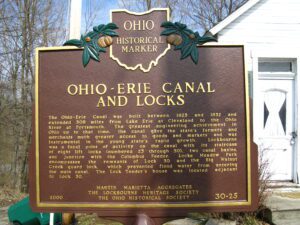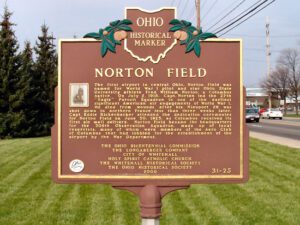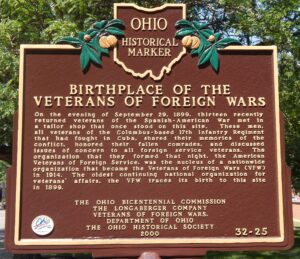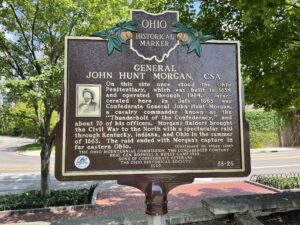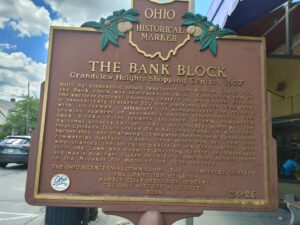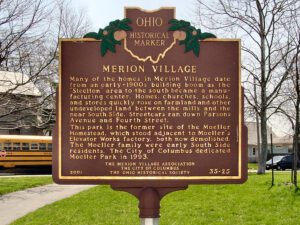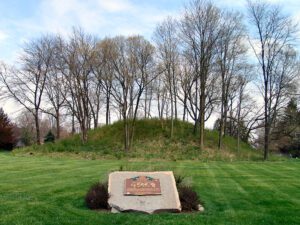, OH
Anticipating a boom in canal commerce, Colonel James Kilbourne (1770-1850) platted Lockbourne in 1831 at the junction of the Ohio-Erie Canal and the Columbus Feeder, which was completed the same year. Lockbourne derives its name from the numerous canal locks at this site and Kilbourne’s own surname. During the heyday of the canal era, Lockbourne boasted the Canal House Hotel, several taverns, a stock yard, a distillery, a sawmill, and a gristmill which used the head of water at Lock 30 for power. (continued on other side)
, OH
The Ohio-Erie Canal was built between 1825 and 1832 and extended 308 miles from Lake Erie at Cleveland to the Ohio River at Portsmouth. The greatest engineering achievement in Ohio up to that time, the canal gave the state’s farmers and merchants much greater access to goods and markets and was instrumental in the young state’s rapid growth. Lockbourne was a focal point of activity on the canal with its staircase of eight lift locks (numbered 23 through 30), two canal basins, and junction with the Columbus Feeder. Locke Meadow Park encompasses the remnants of Lock 30 and the Big Walnut Creek guard lock, which prevented flood water from entering the main canal. The Lock Tender’s house was located adjacent to Lock 30.
, OH
The first airport in central Ohio, Norton Field was named for World War I pilot and star Ohio State University athlete Fred William Norton, a Columbus native. On July 2, 1918, Capt. Norton led the 27th “Eagle” Pursuit Squadron in one of the earliest significant American air engagements of World War I. He died from wounds after his Nieuport 28 was shot down in northern France less than three weeks later. Capt. Eddie Rickenbacker attended the dedication ceremonies for Norton Field on June 30, 1923, as Columbus received its first air mail delivery. Norton Field became the headquarters for the 308th Observation Squadron, made up of local reservists, many of whom were members of the Aero Club of Columbus that had lobbied for the establishment of the airport by the War Department.
, OH
On the evening of September 29, 1899, thirteen recently returned veterans of the Spanish-American War met in a tailor shop that once stood on this site. These men, all veterans of the Columbus-based 17th Infantry Regiment that had fought in Cuba, shared their memories of the conflict, honored their fallen comrades, and discussed issues of concern to all foreign service veterans. The organization that they formed that night, the American Veterans of Foreign Service, was the nucleus of a nationwide organization that became the Veterans of Foreign Wars (VFW) in 1914. The oldest continuing national organization for veterans’ affairs, the VFW traces its birth to this site in 1899.
, OH
On this site once stood the Ohio Penitentiary, which was built in 1834 and operated through 1984. Incarcerated here in July 1863 was Confederate General John Hunt Morgan, a cavalry commander known as the “Thunderbolt of the Confederacy,” and about 70 of his officers. Morgan’s Raiders brought the Civil War to the North with a spectacular raid through Kentucky, Indiana, and Ohio in the summer of 1863. The raid ended with Morgan’s capture in far eastern Ohio. (continued on other side)
, OH
Built by pioneering retail developer Don Monroe Casto Sr., the Bank Block was dedicated in 1928. Considered one of the earliest regional shopping centers in the United States, it innovatively featured 350 free parking spaces-complete with uniformed attendant-to accommodate the rapidly growing numbers of automobile-owning suburbanites. The Bank Block’s first tenants included several competing national grocers (Kroger, A&P, and Piggly Wiggly), the First Citizens Trust (later Ohio National Bank), a stationer, barber shop, and pharmacy. It remains the nucleus of Grandview’s commercial district. Casto, once described as “the man who changed the shopping habits of the free world,” also built the Town and Country Shopping Center in Whitehall and was a dominant figure in retail commercial development in the Midwest for much of the 20th century.
, OH
Merion Village was named for the Nathaniel Merion family, who in 1809 settled what is now the South Side of Columbus on 1800 acres of the Refugee Lands. Entrepreneur William Merion operated “Merion’s Landing” in the 1830s to capitalize on the canal trade from the Columbus Feeder Canal. This area saw a large influx of German immigrants as the South Side industrialized in the mid-nineteenth century. Later, many Irish, Italian, and eastern European immigrants who worked in the local steel mills and foundries made their homes here.
, OH
Archaeologists believe that this prehistoric mound, part of a complex of earthworks, was used for rituals by the Hopewell people and was probably built between 100 BC and 400 AD. Note the painted post tops marking the Hopewell pole house footprint. The mound is recorded on the National Register of Historic Places and was given to the Worthington Historical Society in 1974 in memory of Herman Plesenton Jeffers.


